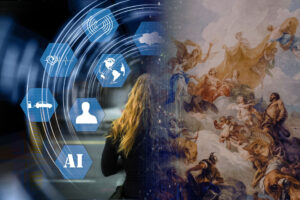In today’s rapidly evolving digital landscape, the fusion of art and technology has catalyzed a revolution in creativity, reshaping how we perceive, create, and interact with art forms.
This dynamic synergy between the realms of artistry and technological innovation has not only redefined traditional artistic practices but has also opened up a plethora of new possibilities, pushing the boundaries of human imagination and expression.
The Evolution of Art in the Digital Age
The intersection of art and technology has transcended conventional boundaries, giving rise to innovative mediums such as digital art, virtual reality (VR), and augmented reality (AR).
Artists now have access to an extensive array of digital tools and platforms that empower them to explore uncharted territories, experiment with new techniques, and connect with global audiences like never before.
Digital Art: Redefining Traditional Canvases

Digital art, characterized by its use of digital technology as a fundamental component of the creative process, has emerged as a groundbreaking medium in contemporary artistry.
From digital paintings and illustrations to multimedia installations and generative art, digital artists leverage cutting-edge software and hardware to materialize their visions with unprecedented precision and fluidity.
Virtual Reality (VR) and Augmented Reality (AR): Immersive Experiences
The advent of VR and AR technologies has revolutionized the way we experience art, offering immersive and interactive encounters that transcend the confines of physical space.
Through VR headsets and AR applications, viewers can step into virtual galleries, explore immersive installations, and even interact with digital artworks in real time, blurring the line between the physical and virtual worlds.
Transforming Artistic Expression and Engagement
Beyond its impact on the creation and presentation of art, the fusion of art and technology has also revolutionized how audiences engage with artistic content, fostering new modes of participation, collaboration, and cultural exchange.
Democratization of Artistic Expression
Technology has democratized the creative process, empowering individuals from diverse backgrounds to express themselves artistically and share their work with global audiences instantly. Platforms such as social media, online galleries, and crowdfunding platforms have facilitated the proliferation of grassroots art movements, enabling emerging artists to gain recognition and support outside of traditional institutional frameworks.
Interactive and participatory art experiences
The integration of interactive and participatory elements in art installations and exhibitions has redefined the role of the viewer, inviting them to actively engage with the artwork and become co-creators of the experience.
From interactive installations that respond to viewer movements to collaborative digital projects that invite online participation, technology has catalyzed a shift towards more dynamic and inclusive forms of artistic engagement.
Navigating the Ethical and Social Implications
As we embrace the transformative potential of technology in art, it is imperative to critically examine the ethical and social implications inherent in this paradigm shift.
Issues such as data privacy, digital ownership, and algorithmic bias raise important questions about the equitable distribution of resources and access within the digital art ecosystem, challenging us to ensure that technological advancements are leveraged responsibly and inclusively.
Addressing the Digital Divide and Accessibility
While technology has undoubtedly expanded the reach and accessibility of art, it is essential to acknowledge and address the digital divide that persists in many communities, limiting access to resources and opportunities for marginalized individuals.
Efforts to bridge this gap through initiatives such as digital literacy programs, community art projects, and inclusive design practices are crucial in fostering a more equitable and inclusive artistic landscape.
Synergy of Content Creation, Web Development with Art & Technology:
In the modern landscape, the convergence of content creation, web development, and art & technology forms a dynamic nexus driving innovation and creativity.
Content creation serves as the narrative backbone, crafting compelling stories and contexts that breathe life into digital artworks and experiences.
Meanwhile, web development provides the infrastructure, to construct immersive platforms and digital galleries that amplify the reach and accessibility of artistic endeavors.
Together, these elements intersect with art & technology, fueling a renaissance of expression where boundaries blur between mediums and disciplines.
This symbiotic relationship fosters a fertile ground for experimentation and exploration, pushing the boundaries of artistic possibility while reshaping the digital landscape.
Conclusion: Embracing the Future of Art and Technology 
The intersection of art and technology represents a transformative force that continues to shape the landscape of creativity in profound ways. From the emergence of new artistic mediums to the democratization of artistic expression and the exploration of immersive experiences, the fusion of art and technology offers boundless opportunities for innovation, collaboration, and cultural exchange. By embracing this synergy and navigating its ethical and social implications with vigilance and compassion, we can unlock the full potential of art and technology to inspire, connect, and empower individuals and communities around the globe.
Content Writing: Frequently Asked Questions (FAQs)
- What is the significance of exploring the intersection of art and technology?
– The exploration of art and technology’s intersection sheds light on the transformative impact of technology on artistic expression and the societal implications of this convergence.
- How has digital art evolved in the 21st century?
– Digital art has evolved significantly, with artists utilizing cutting-edge technologies to create immersive experiences, challenging traditional artistic norms, and blurring the lines between physical and virtual mediums.
- How has technology transformed the way art is exhibited and accessed by audiences?
– Technology has democratized the art world by enabling artists to showcase their work globally through online platforms and social media. Additionally, virtual galleries and digital exhibitions offer audiences unprecedented access to art collections, transcending geographical barriers.
- What role does technology play as a medium for artistic exploration?
– Technology serves as a medium for artistic expression, allowing artists to utilize code, software, and AI algorithms to create innovative artworks that engage with social issues and challenge existing power structures.
- What does the future hold for the intersection of art and technology?
– The future of art and technology promises endless possibilities for innovation, from AI-generated artworks to immersive virtual reality experiences. However, it also raises questions about the ethical implications of technological advancements on the art world and society.
- How can artists responsibly navigate the evolving landscape of art and technology?
– Artists can navigate the intersection of art and technology responsibly by embracing the transformative potential of technology while critically examining its impact on artistic practices and societal dynamics.
- How can individuals engage with and contribute to the dynamic intersection of art and technology?
– Individuals can engage with the intersection of art and technology by exploring digital art, attending virtual exhibitions, and supporting artists who leverage technology in their creative processes. Additionally, fostering discussions about the ethical implications of technological advancements is crucial for shaping the future of art and society.
- What resources are available for those interested in learning more about art and technology?
– There are various resources available, including online courses, workshops, and academic publications, that delve into the multifaceted relationship between art and technology. Additionally, engaging with online communities and attending art and technology events can provide valuable insights and opportunities for collaboration.




